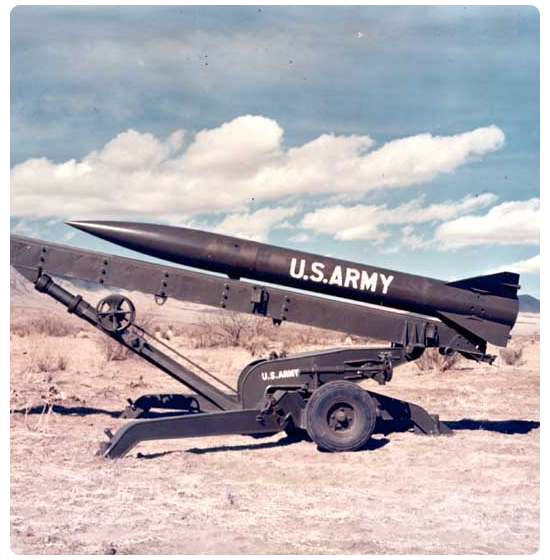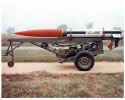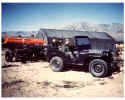The LITTLEJOHN was a free flight artillery rocket designed to deliver the explosive power of heavy artillery. It could carry either nuclear or conventional warheads. Designed primarily for use in airborne assault operations, the highly mobile LITTLEJOHN rocket system complemented the heavier, self-propelled HONEST JOHN systems. The LITTLEJOHN reached the field in November 1961 and remained in the Army inventory until August 1969.




|
System Chronology
|
May 53 Assistant Chief of Ordnance outlined plans for studies of a family of atomic rocket weapons based on the HONEST JOHN and having overlapping tactical range capabilities. The "JOHN family" was to include the middle-range HONEST JOHN, the shorter-range HONEST JOHN Junior, and the longer-range HONEST JOHN Senior. Douglas Aircraft Corporation began engineering studies of the HONEST JOHN Junior, which was the progenitor of the LITTLEJOHN. 1953-1954 Several different configurations for the short-range system were considered, but they bore little resemblance to the design and performance characteristics ultimately adopted for the LITTLEJOHN. Engineering studies for the shorter-range system were conducted under a basic research and development contract with Douglas. August 54 DA approved a firm requirement for the HONEST JOHN Junior and directed the Chief, Army Field Forces to prepare formal military characteristics for the system. Redstone Arsenal began design studies of the system. December 54 Office, Chief of Ordnance (OCO) set up the project framework for development of a new weapon system known as the LITTLEJOHN rather than the HONEST JOHN Junior. February 55 Redstone Arsenal began preliminary design studies for the complete LITTLEJOHN system. June 55 DA approved the military characteristics for the LITTLEJOHN. 14 June 55 The LITTLEJOHN project was formally established. Primary responsibility for the execution of the project was assigned to Redstone Arsenal . Because it was unable to obtain an acceptable proposal from Douglas (the company had a problem with accepting the contract's proprietary rights clause without a substantial increase in the fixed fee), Redstone Arsenal assumed the role of prime contractor for the system as well as exercised technical supervision and control of the overall project. August 55 Army General Staff directed the Chief of Ordnance to stop work on the 17.35-inch round and develop the LITTLEJOHN rocket for delivery of a smaller atomic warhead about 11.5-inches in diameter. 9 September 55 The 440mm (17.35-inch) LITTLEJOHN was officially terminated, and the program was reoriented toward development of a smaller rocket. The Chief of Ordnance also issued a policy directive stating that the motor would be Government-furnished equipment and launching equipment would be the responsibility of the Ordnance Weapons Command, but responsibility for the design, development, and testing of the rocket was to be placed with a civilian industrial firm. January 56 LITTLEJOHN project was reoriented into two phases: an interim and optimum system. Development of the interim LITTLEJOHN began, although some preliminary laboratory work had been done in the last quarter of FY 1955. The immediate objective of this phase was to develop on a crash basis an interim atomic delivery vehicle for use in airborne operations. Emphasis was placed on early field delivery rather than accuracy. The Phase II LITTLEJOHN was also initiated as a parallel effort to Phase I. The second phase was planned as a 30-month program, with an estimated cost $2.1 million, which eventually soared to 54 months and $37.6 million. The objective of this phase was to develop an optimum system having improved accuracy, a lighter system weight, an improved motor, a dual warhead delivery capability, and a self-propelled launcher. It was to be a free flight rocket capable of delivering both atomic and conventional payloads to a maximum range of 20,000 yards and a minimum range of not more than 3,500 yards. Little was accomplished on this phase, however, pending the availability of detailed warhead characteristics in December 56. February 56 Redstone Arsenal awarded Emerson Electric Manufacturing Company a $213,688 contract for the design, development, and fabrication of 20 sets of airframe components and sufficient tooling to produce components at a rate of 24 sets per month by 1 September 56. July 56 The feasibility phase of the flight test program started 3 months early, but it was disrupted by a nationwide steel strike which delayed motor deliveries for 6 weeks. Although this delay was made up by January 57, the program suffered another setback because of rocket launcher interference problems. October 56 New military characteristics for the interim LITTLEJOHN were the same as those established in July 55, except for a more detailed definition of the desired operational characteristics of a helicopter-transportable launcher to be developed for the interim system. January 57 Formal development of the optimum system began. May-5 June 57 The final development (armed) firings were conducted. A statistical analysis of the results indicated that the accuracy of the interim LITTLEJOHN fell considerably short of that originally predicted. July 57 The Phase I LITTLEJOHN was completed as scheduled, but it failed to meet the minimum accuracy requirement. Consequently, it was never released for tactical use, but was used for troop training purposes only. 16 July 57 Redstone Arsenal made the formal research and development release of the interim LITTLEJOHN. Initial troop deliveries were delayed so that an investigation could be conducted to determine a field-type retrofit to allow the original accuracy estimate to be realized. 26 July - 23 August 57 A combined engineer-user test program was conducted because the interim LITTLEJOHN did not meet the proposed military characteristics regarding accuracy and the system was not sufficiently accurate to deliver the T317E1 warhead. These tests isolated the major source of the LITTLEJOHN accuracy problem. Although a fix was determined, the retrofit was disapproved. August 57 The 101st Airborne Division, Fort Campbell, Kentucky, received the initial issue of Phase I LITTLEJOHN units. Deliveries continued though early 1958. The Continental Army Command (CONARC) subsequently decided that the weapon system was unsuitable for general troop use. The interim LITTLEJOHN was retained for training and development of combat techniques pending the availability of the optimum LITTLEJOHN. 1 April 58 Responsibility for the LITTLEJOHN program was transferred to the U.S. Army Rocket and Guided Missile Agency (ARGMA). May 58 In accordance with directions from higher authority, the Chief of Ordnance advised CONARC that no further work would be done on the Phase I LITTLEJOHN except that which was directly applicable to the development of the Phase II system. The Ordnance Corps retained the interim LITTLEJOHN in active war reserve status for the next 28 months. 16 September 58 Office, Chief of Research and Development canceled the requirement for a self-propelled LITTLEJOHN system and directed the Chief of Ordnance to terminate that portion of the development program. December 58 - October 59 Phase II development testing was conducted at White Sands Missile Range. During the course of the test program, the ARGMA Research and Development Division finalized the design of the tactical LITTLEJOHN and accomplished the conditional release of research and development drawings to the ARGMA Industrial Division for limited production. July 59 Industrial participation in the Phase II LITTLEJOHN program officially began with the initiation of pre-production studies. 15 October 59 Conditional research and development release of the XM-51 LITTLEJOHN rocket (less warhead), the XM-34 launcher, and all items of ground support equipment, except the XM-85E3 conditioning kit and truck-mounted handling unit was accomplished. November 59 DA classified the Phase II LITTLEJOHN as limited production. Limited procurement of system components was initiated. 1 July 60 ARGMA Research and Development Division released the final research and development drawings and documentation for the XM-51 rocket, XM-34 launcher and ancillary equipment, XM-8 practice warhead, and T54 high explosive warhead to the ARGMA Industrial Division. Primary mission control for the LITTLEJOHN program passed from the Research and Development Division to the Industrial Division. August 60 The number of available XM-47 interim LITTLEJOHN rockets (less warheads) totaled 67 rounds: 42 in war reserve at the Blue Grass Ordnance Depot; 10 held by the 101st Airborne Division; 3 assigned to White Sands Missile Range for use as HAWK targets; and 12 rejected for war reserve or troop training because of minor dimensional defects. 29 September 60 The Phase I LITTLEJOHN program was terminated. January & March 61 The first two Phase II LITTLEJOHN battalions were activated. May 61 The delivery of the FY 1960 Phase II LITTLEJOHN production units began at the rate of 60 per month. August 61 Major deficiencies in the Phase II LITTLEJOHN, uncovered during engineer-service testing, were corrected to the user's satisfaction. Pertinent military characteristics were also met, except for the low temperature firing limit of the XM-26E1 motor. September 61 All components of the Phase II LITTLEJOHN, except the chemicall atomic warheads and the improved XM-85E4 conditioning kit, were classified Standard A. September 61 - August 65Industrial engineers focused attention on the refinement and improvement of the standard LITTLEJOHN weapon system, with primary emphasis on the correction of known shortcomings and deficiencies. November 61 The Phase II LITTLEJOHN weapon system was initially deployed with the 1st Missile Battalion, 57th Field Artillery to Okinawa. 1 August 62 LITTLEJOHN program initially placed in the Product Manager category under the Deputy Commanding General (DCG), Ballistic Missiles at MICOM. October 62 The DCG, Ballistic Missiles was redesignated the DCG, Land Combat Systems. LITTLEJOHN and HONEST JOHN were merged under a single product manager, who later became a commodity manager. 1964 All components of the tactical LITTLEJOHN system, except the XM-185 high explosive warhead, were service tested and classified as Standard A. 26 October 64 The LITTLEJOHN/HONEST JOHN Commodity Office management functions were transferred to the newly formed Land Combat Commodity Office. August 65 The bulk of the product improvement effort for the Phase II LITTLEJOHN was completed in mid-1965. The project was officially terminated. 30 June 66 During the 12-year period 1 July 54 to 30 July 66, DA invested nearly $100 million in all phases of the LITTLEJOHN program. November 66 Of the seven tactical LITTLEJOHN units initially deployed in 1961, only four were still active. December 66 Two tactical LITTLEJOHN units were deployed in the South Pacific and two were deployed in the continental United States (CONUS). August 69 The LITTLEJOHN was type classified as obsolete. |
